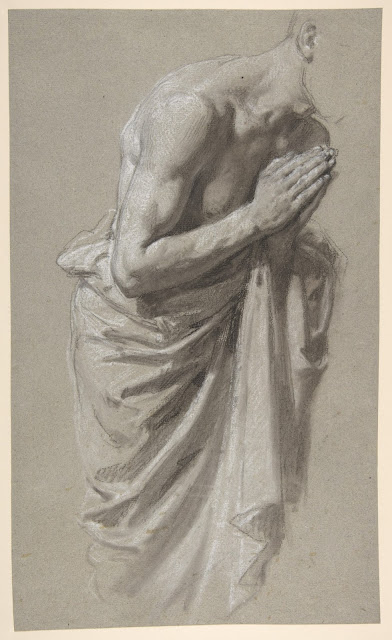 |
| Jean Victor Bertin Arched bridge early 19th century drawing Ashmolean Museum, Oxford |
 |
| attributed to Antonio de Pian Loggia by a river 19th century drawing Morgan Library, New York |
 |
| attributed to Antonio de Pian Round temple 19th century drawing Morgan Library, New York |
 |
| John Constable Landscape study 1829 drawing British Museum |
"Constable was deeply ambivalent about the relationship between art and emotion. On the one hand he believed that authentic art grew out of the artist's emotional life, but on the other he held that painting maintained an intimate connection to knowledge and as such was indifferent to feeling, whether of the artist or the viewer. There is a story that illustrates this ambivalence very well. One day when the visionary artist William Blake was looking through one of Constable's sketchbooks, he stopped at a picture of some fir trees and exclaimed that it was 'not drawing but inspiration.' This was the highest compliment Blake could pay Constable; he meant that Constable had transcended the visible condition of the trees and had been able to express their invisible reality, their spiritual 'truth.' But it was a compliment that Constable could not accept; feigning ignorance of these concerns, he replied rather priggishly, 'I never knew it before; I meant it for drawing.'"
– from Constable by Jonathan Clarkson (London : Phaidon Press, 2010)
 |
| Isidore Pils Figure study for a soldier 19th century drawing Metropolitan Museum of Art, New York |
 |
| Isidore Pils Figure study for Clovis 19th century drawing Metropolitan Museum of Art, New York |
 |
| Eugène Delacroix Man and Woman 1835 drawing Ashmolean Museum, Oxford |
 |
| Jean-Auguste-Dominique Ingres Odalisque ca. 1824-34 grisaille Metropolitan Museum of Art, New York |
 |
| Édouard Manet Proof prints of vignettes for an edition of Mallarmé 1875 woodcuts British Museum |
 |
| Édouard Manet Swallows 1874 etching British Museum |
 |
| Benjamin Robert Haydon Study for the figure of Solomon 1812 drawing British Museum |
 |
| Benjamin Robert Haydon Study for the figure of Christ early 19th century drawing British Museum |
 |
| Benjamin Robert Haydon Study of a sculpture early 19th century drawing British Museum |
 |
| Benjamin Robert Haydon Seated figure 1810 drawing British Museum |
A friend and correspondent of John Keats, the artist Benjamin Robert Haydon (1786-1846) belonged to a generation with a particular talent for unhappiness. According to David Blayney Brown, "Haydon was greatly impressed by the Elgin Marbles from the Parthenon frieze, of which he made drawings in 1808. He championed them vociferously. Unfortunately the marbles encouraged Haydon's injudicious preference for working on a vast scale. ... The last major English painter in the historical grand style of Reynolds, he was as much the victim of his overweening ambition and combative personality as of changing tastes, and his sense of his own genius – a Romantic concept wholly in keeping with the period – was regrettably greater than his genius itself."